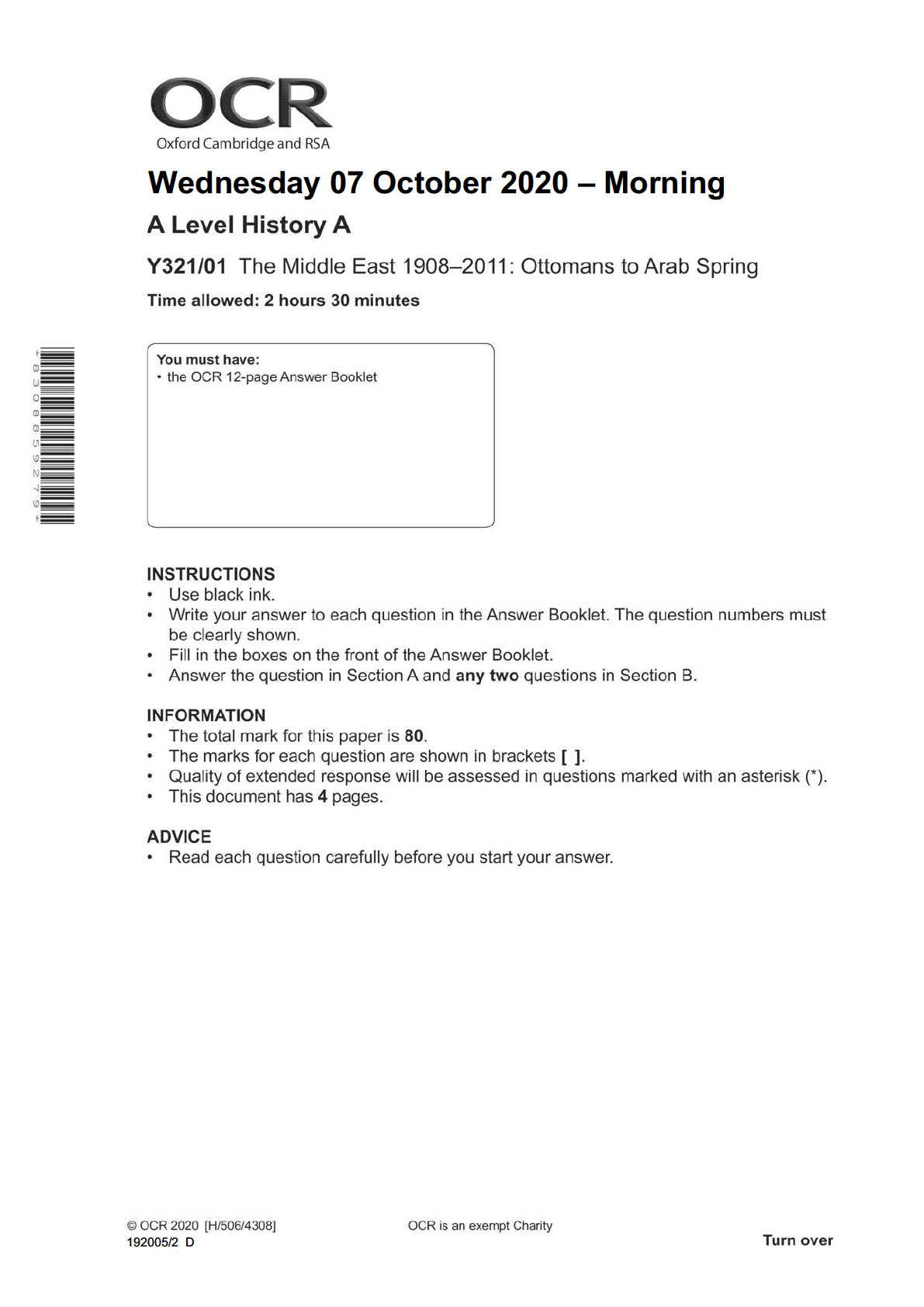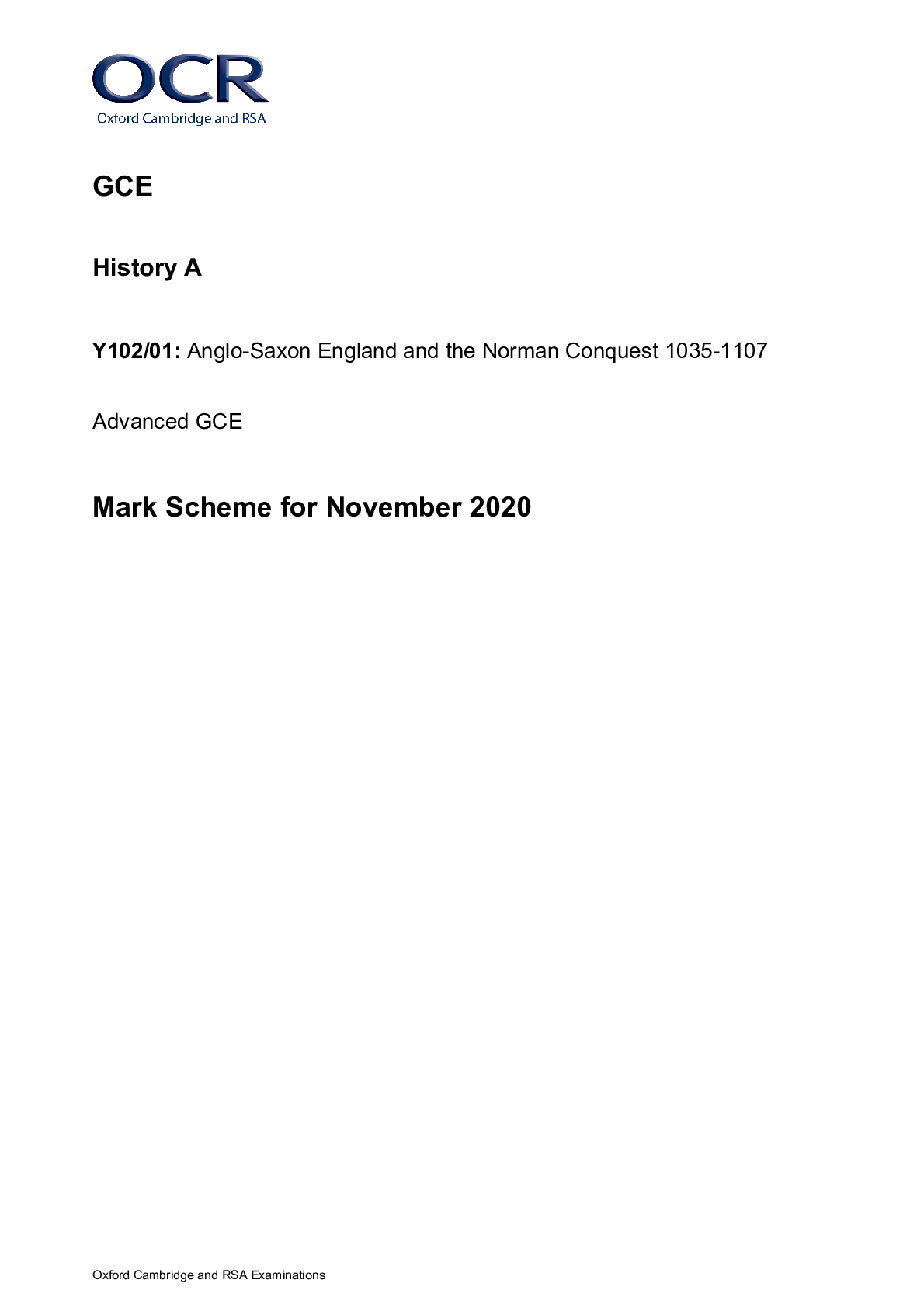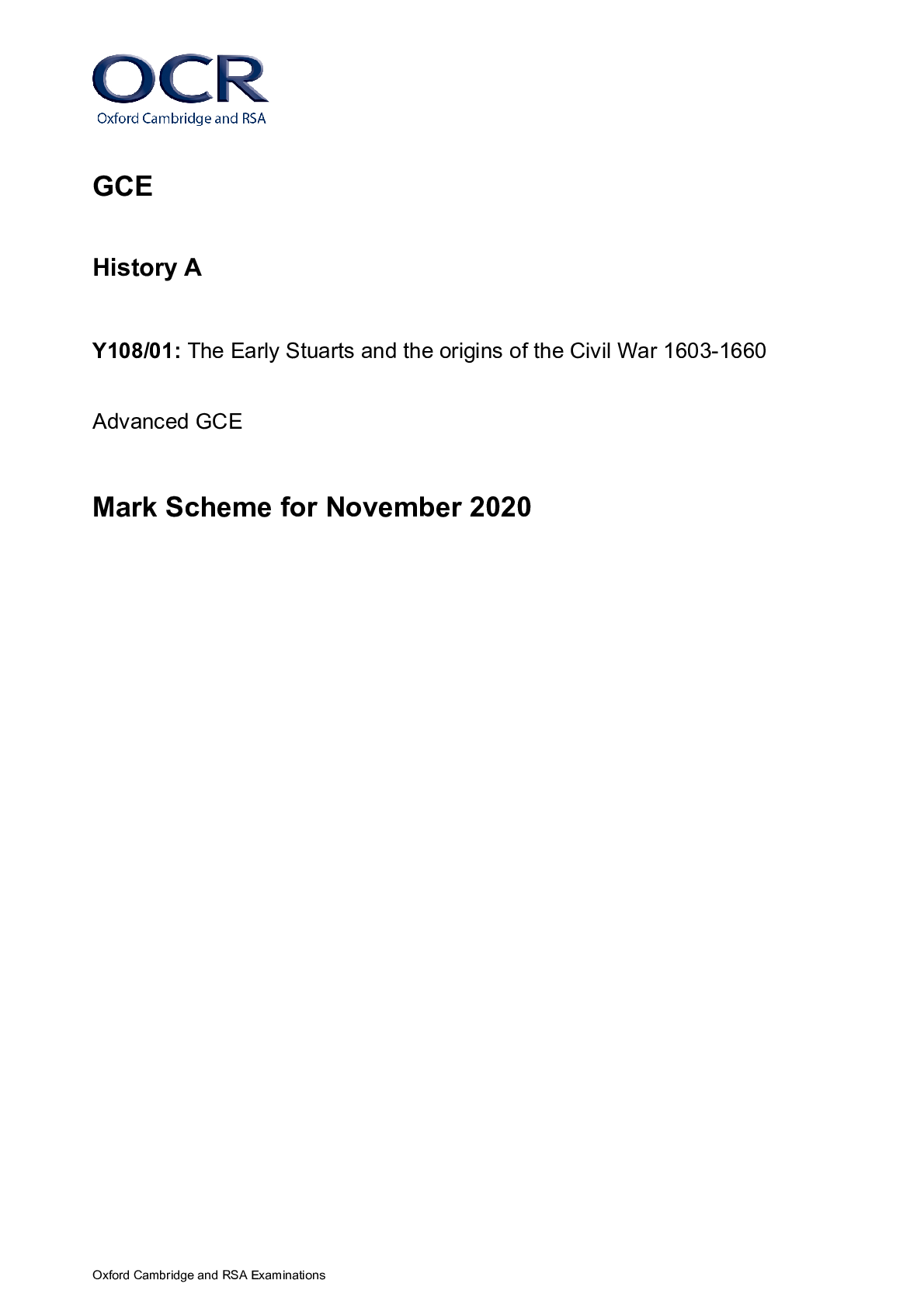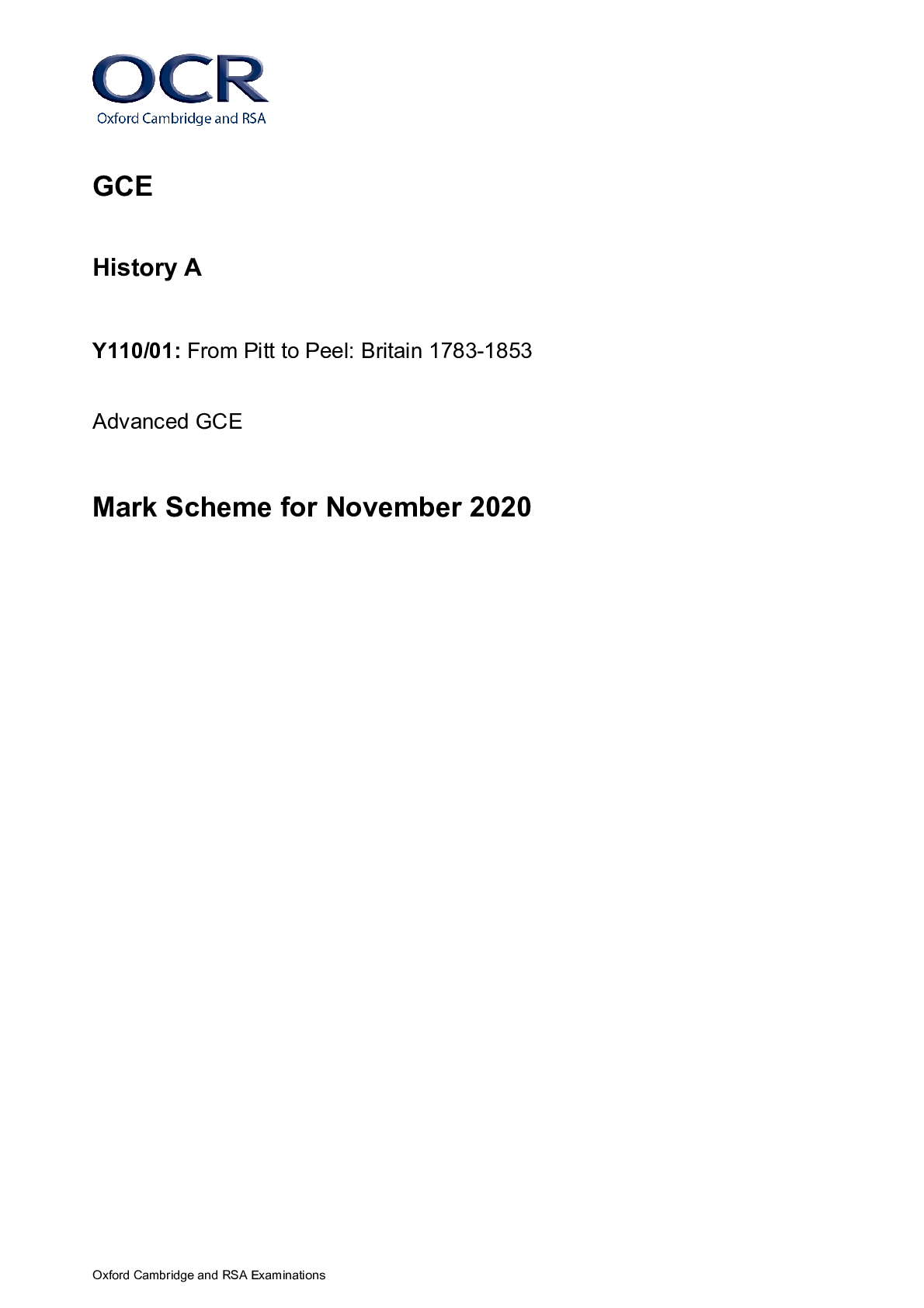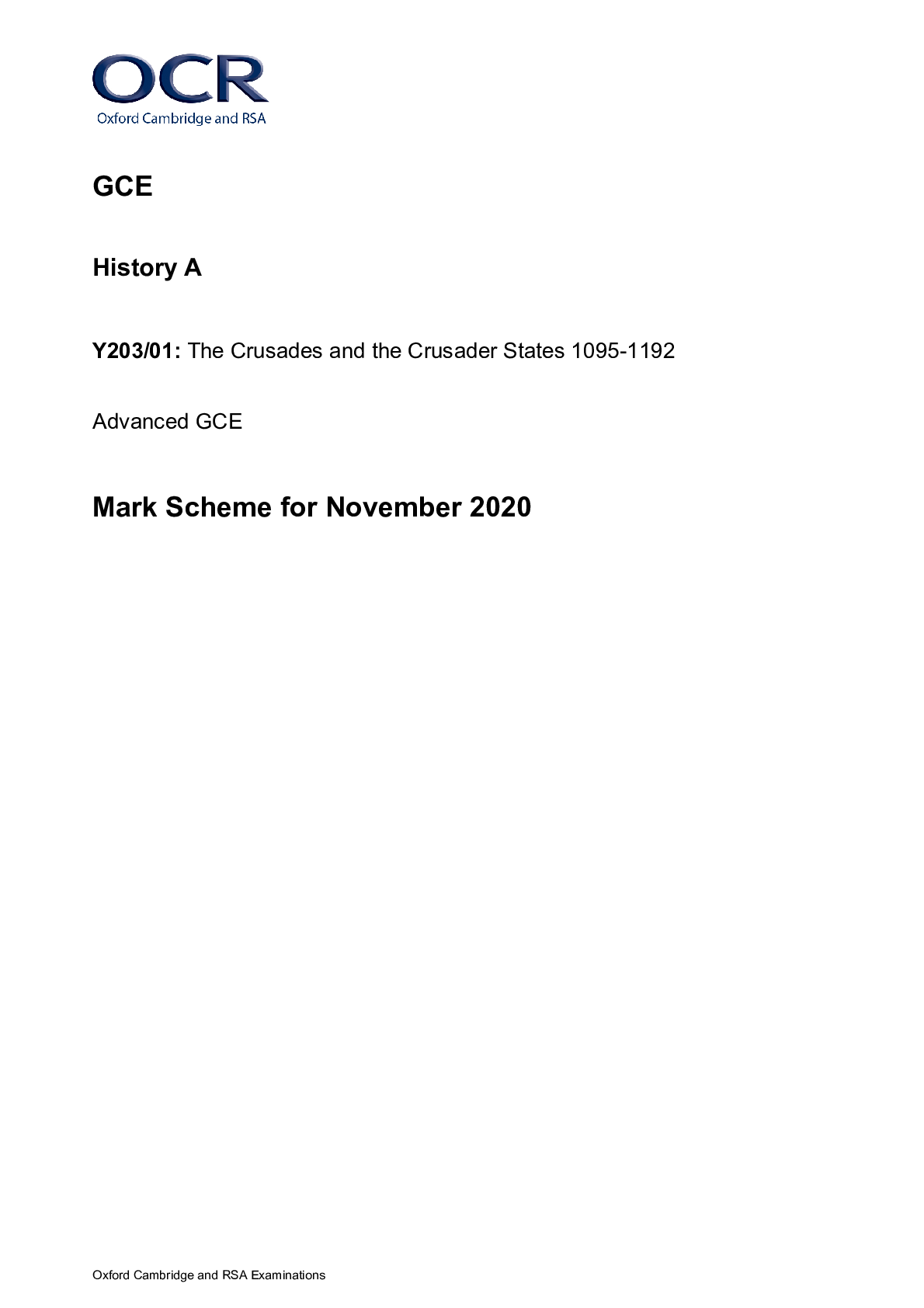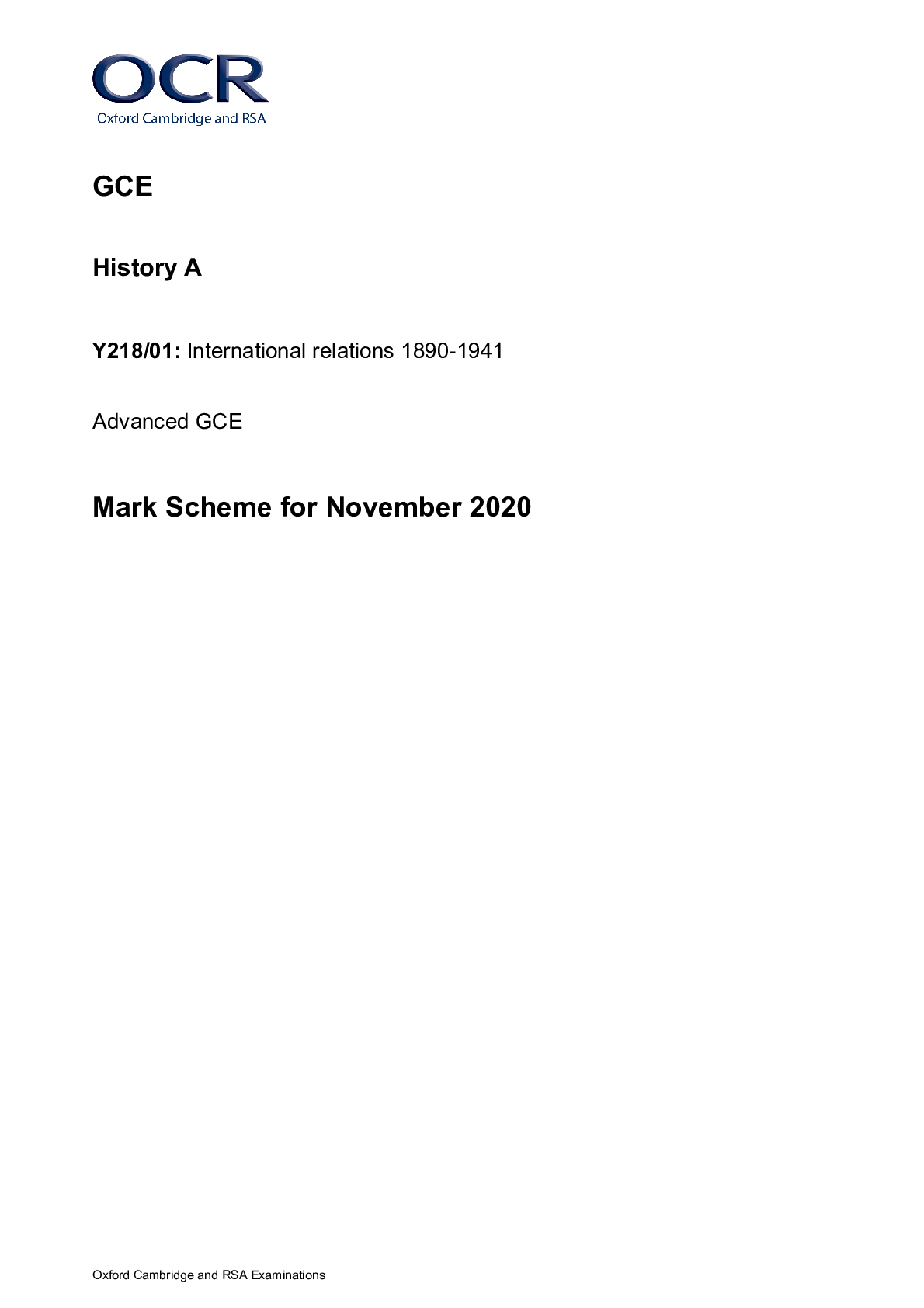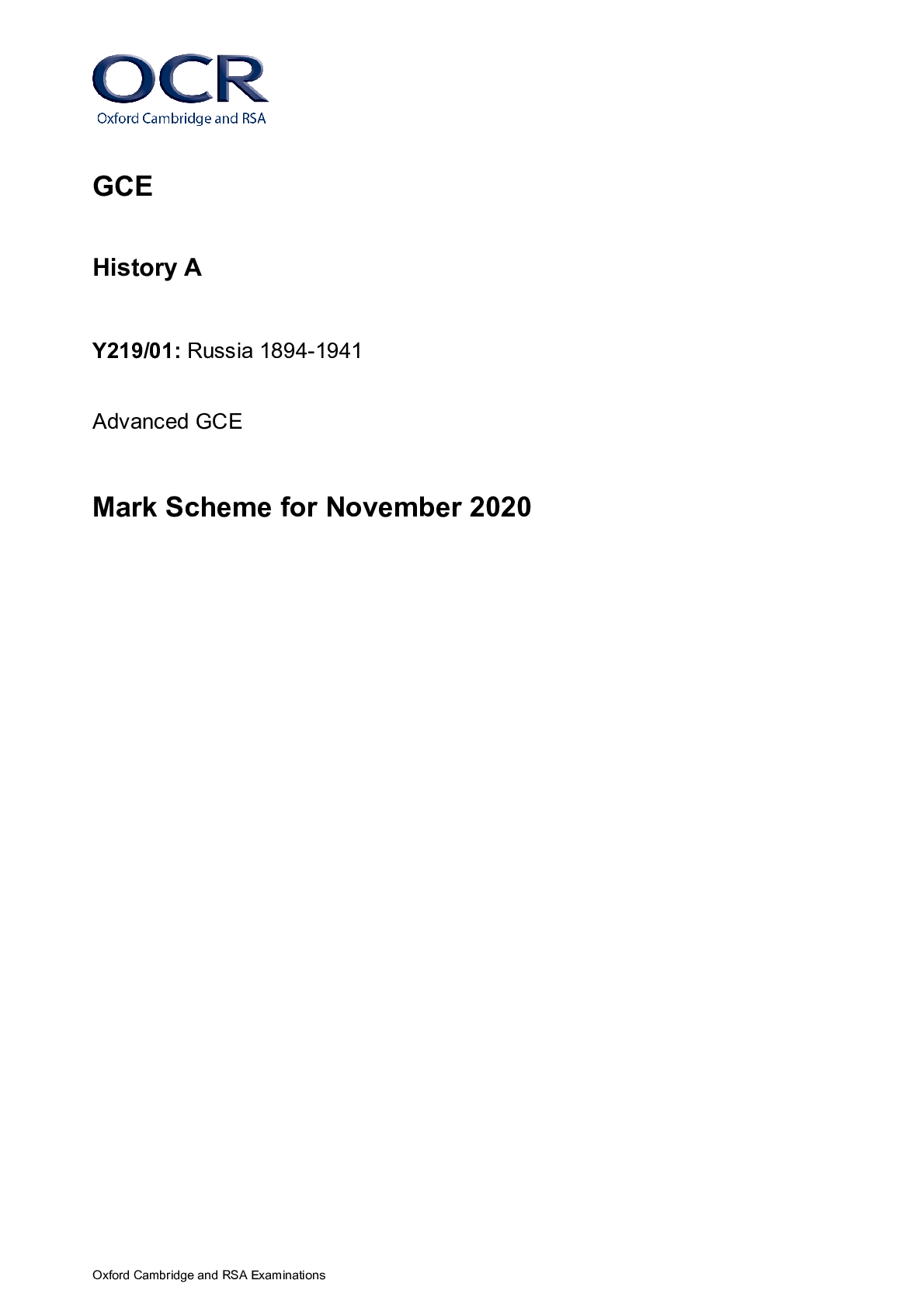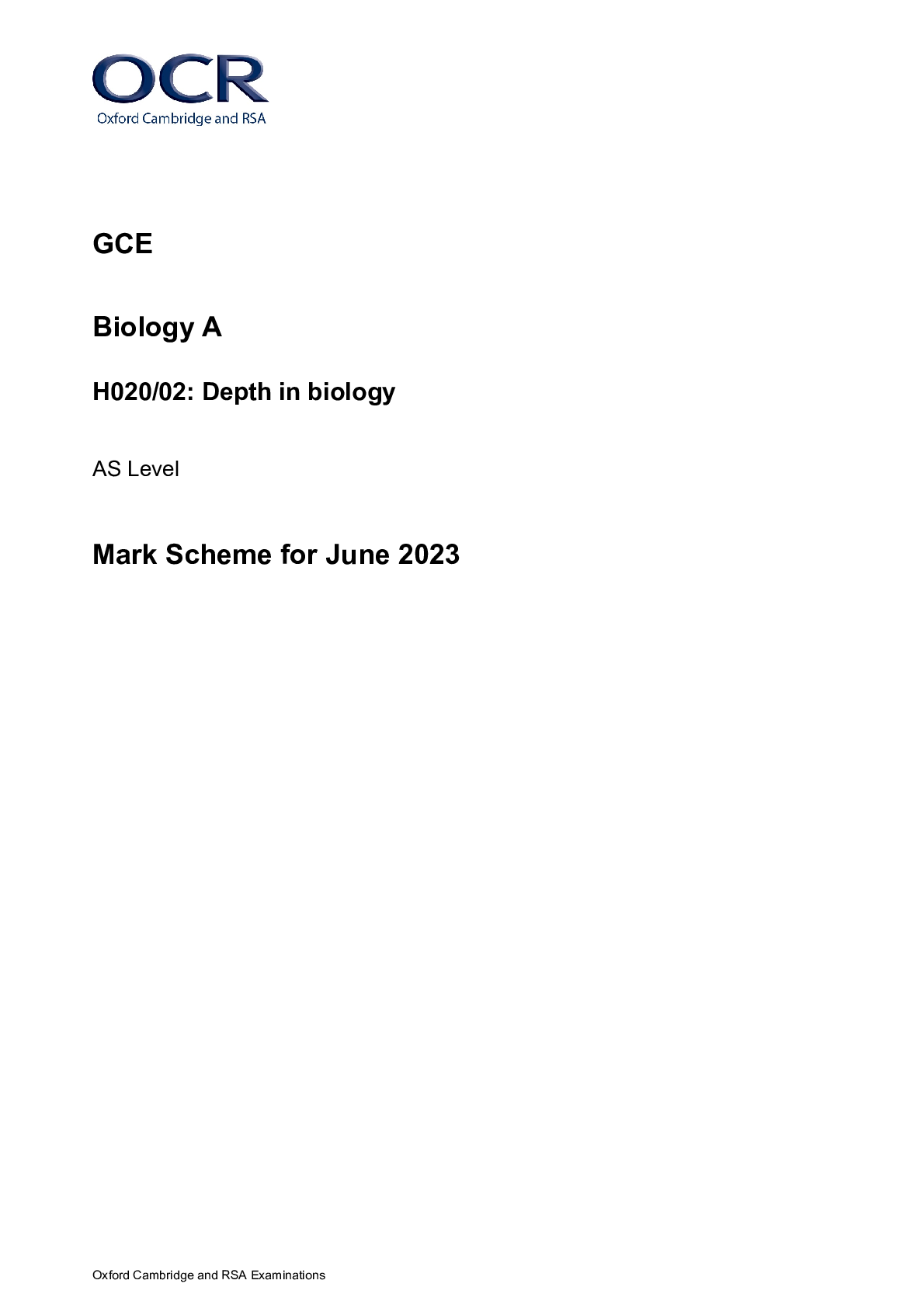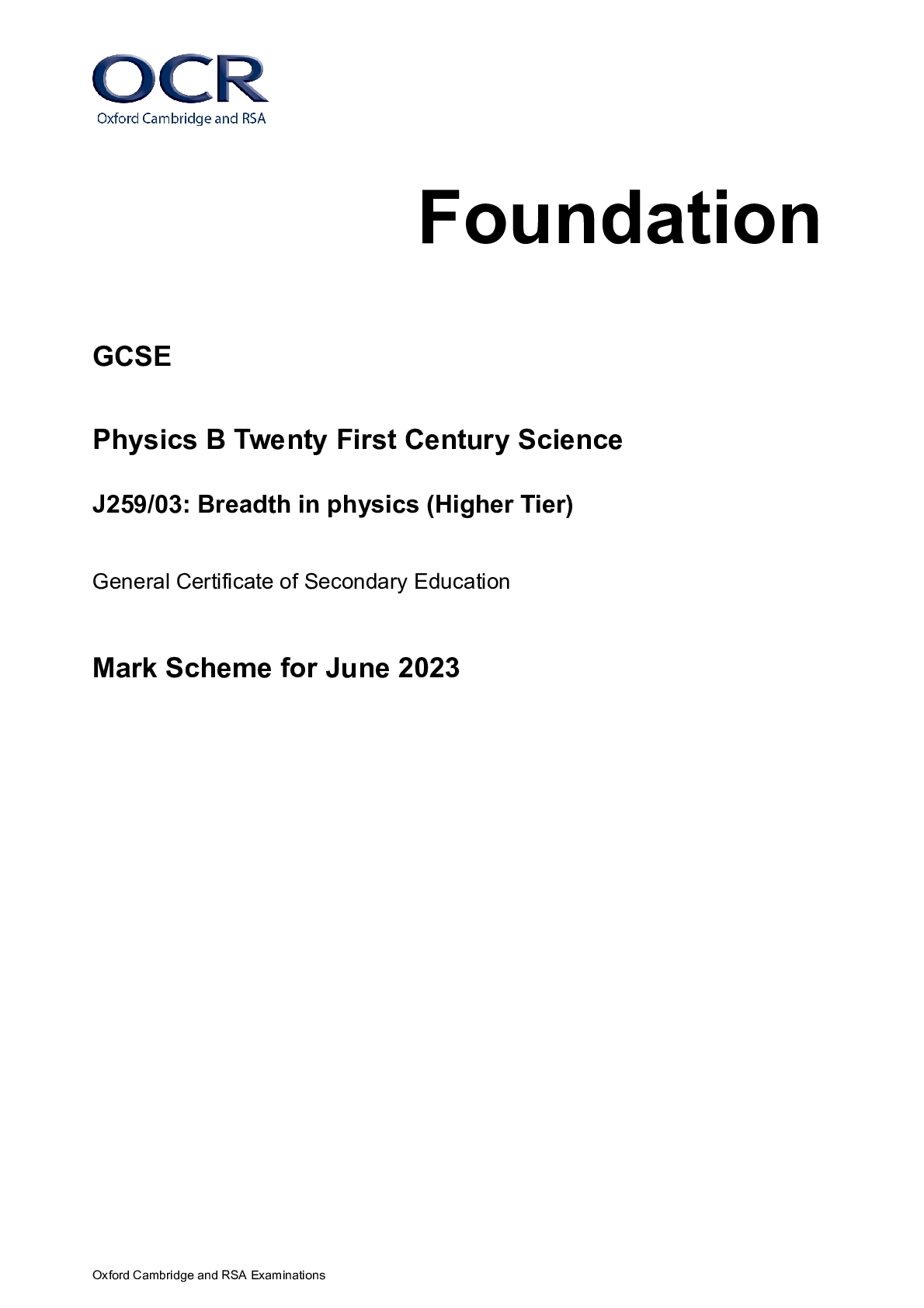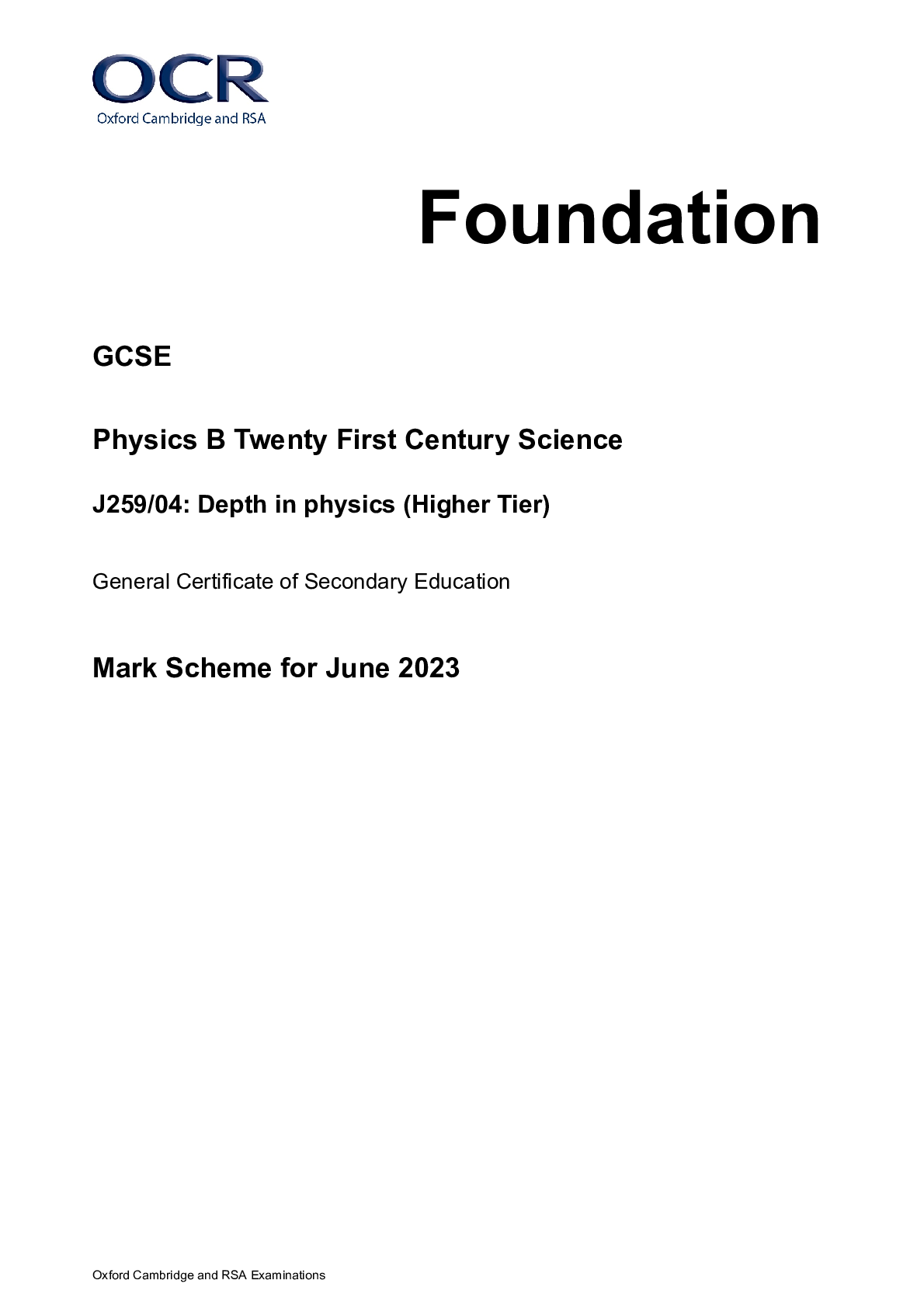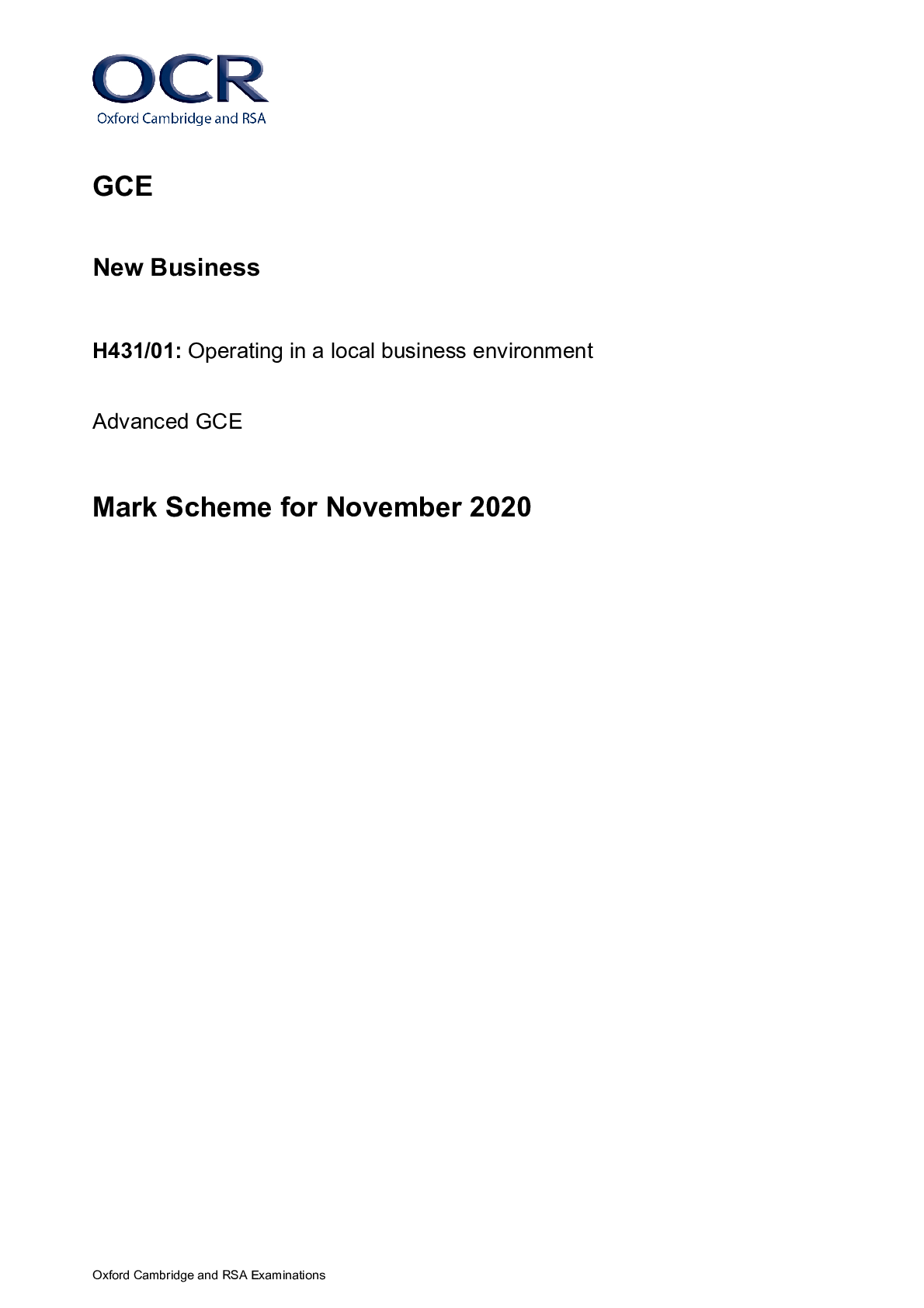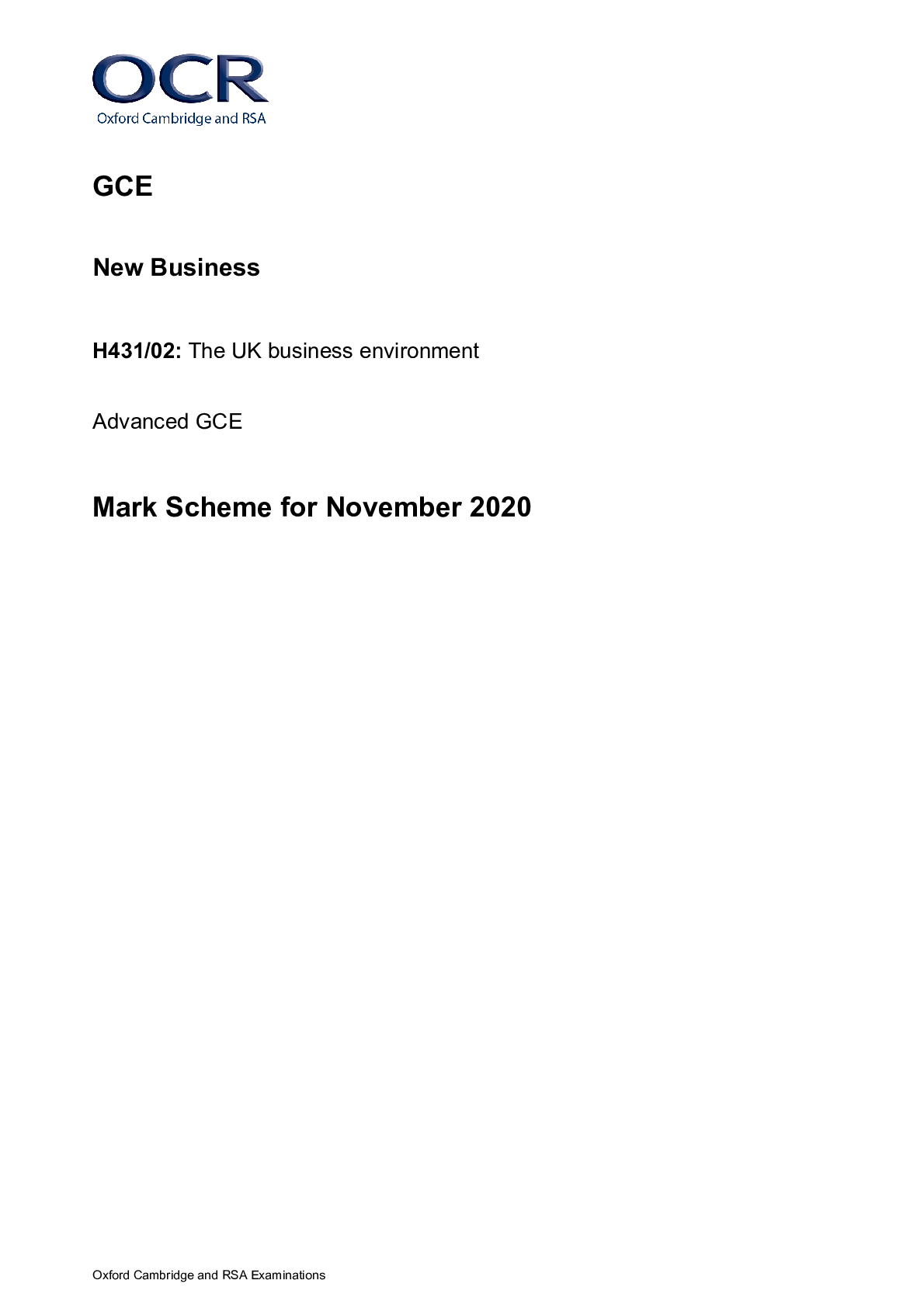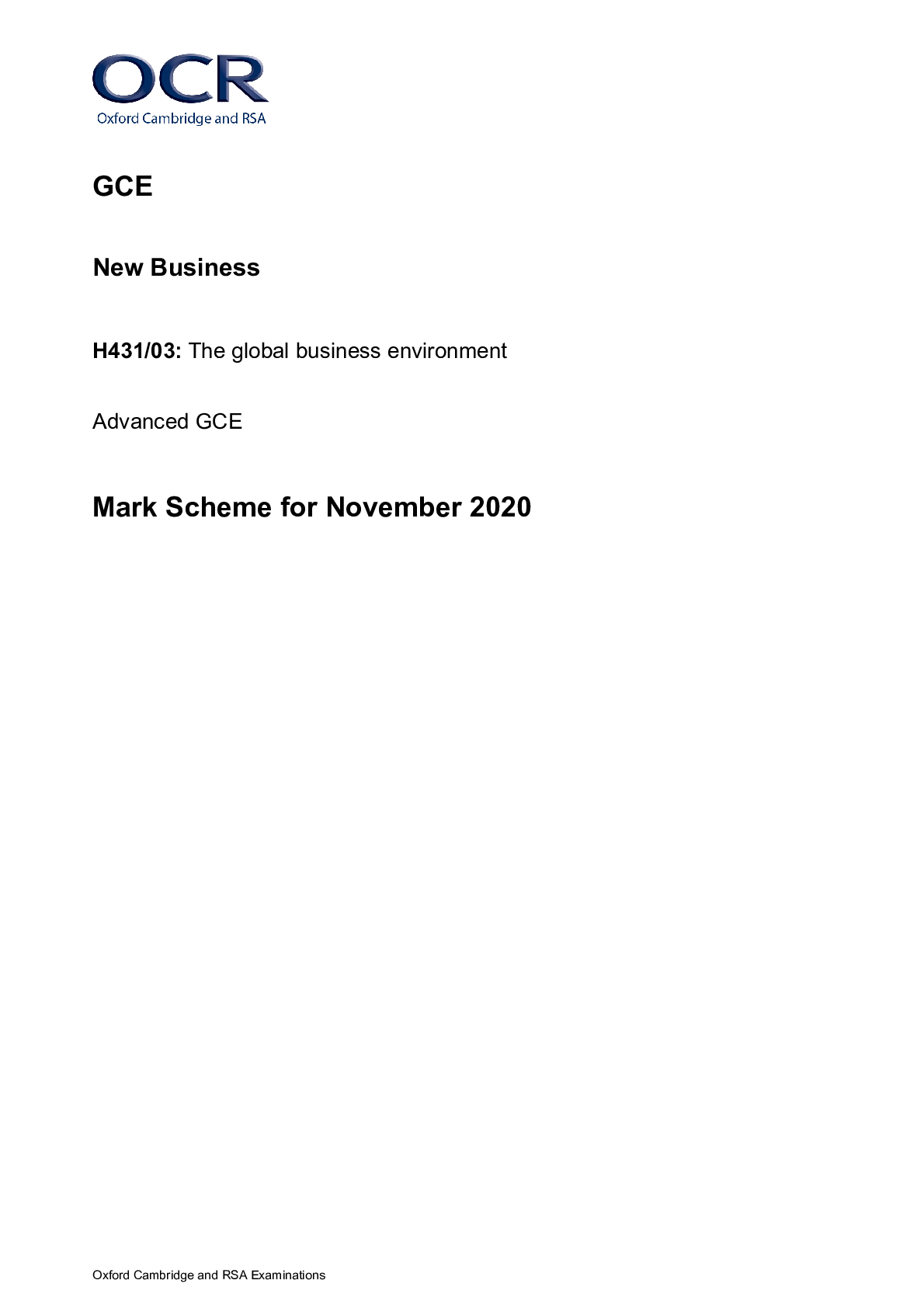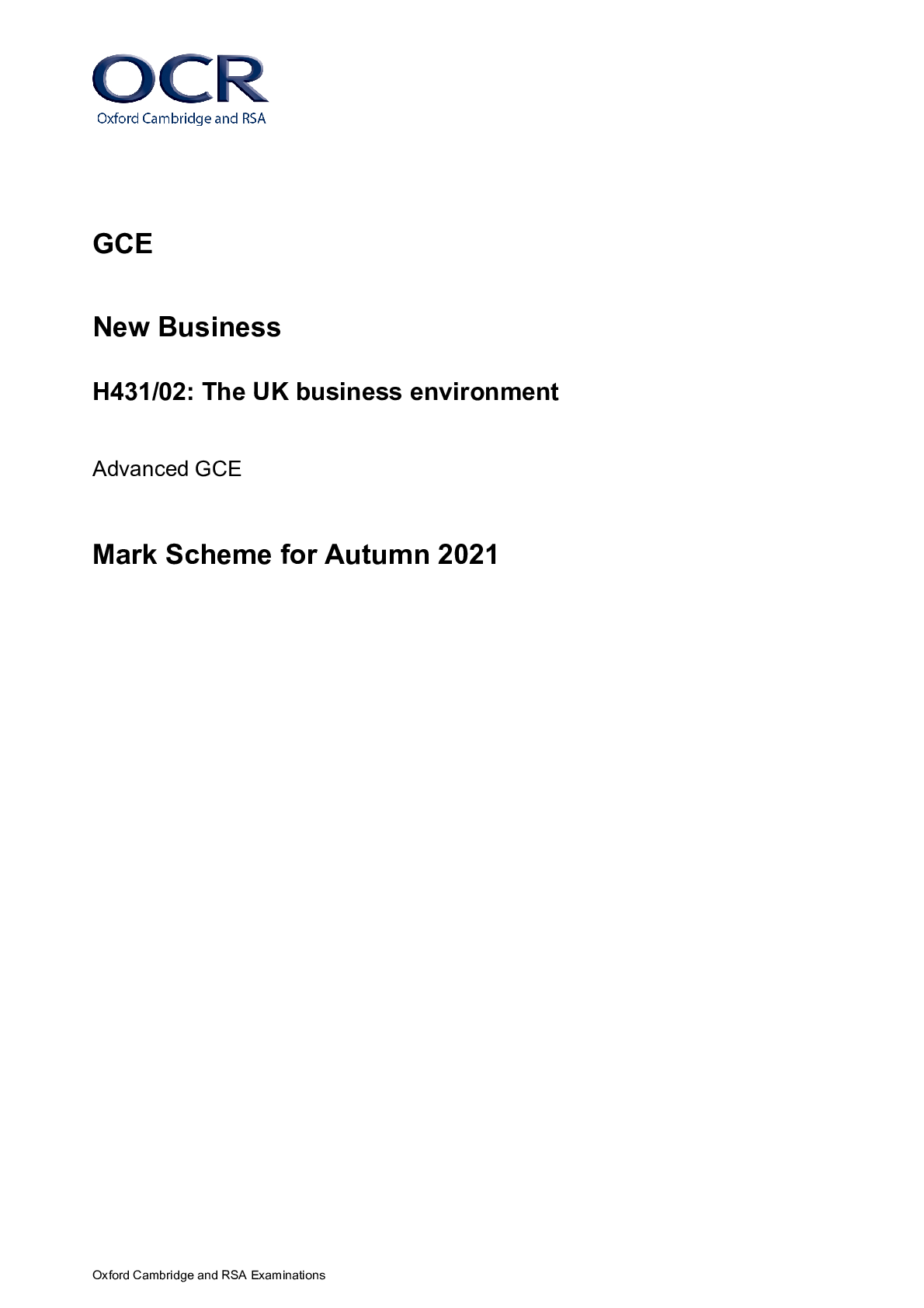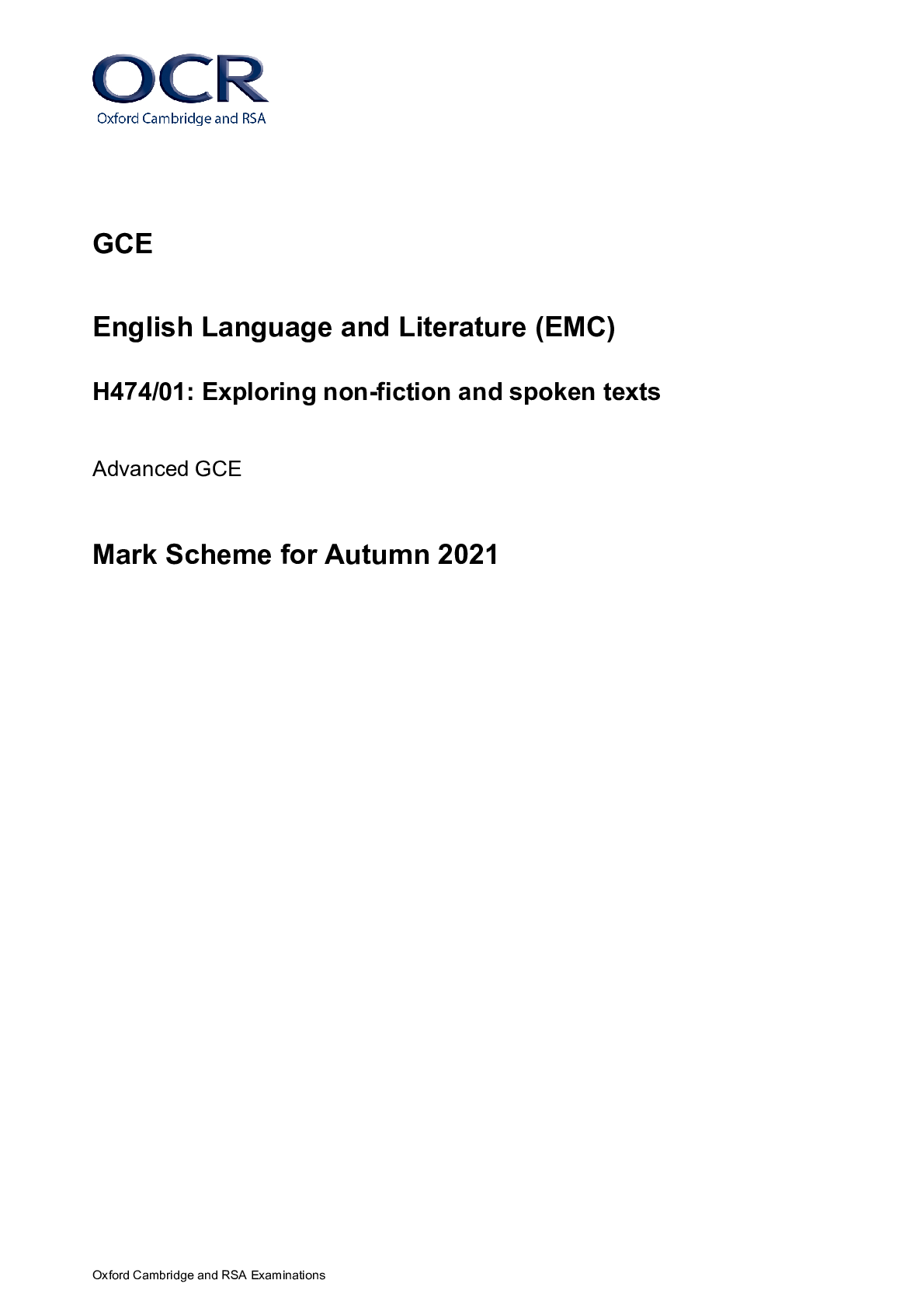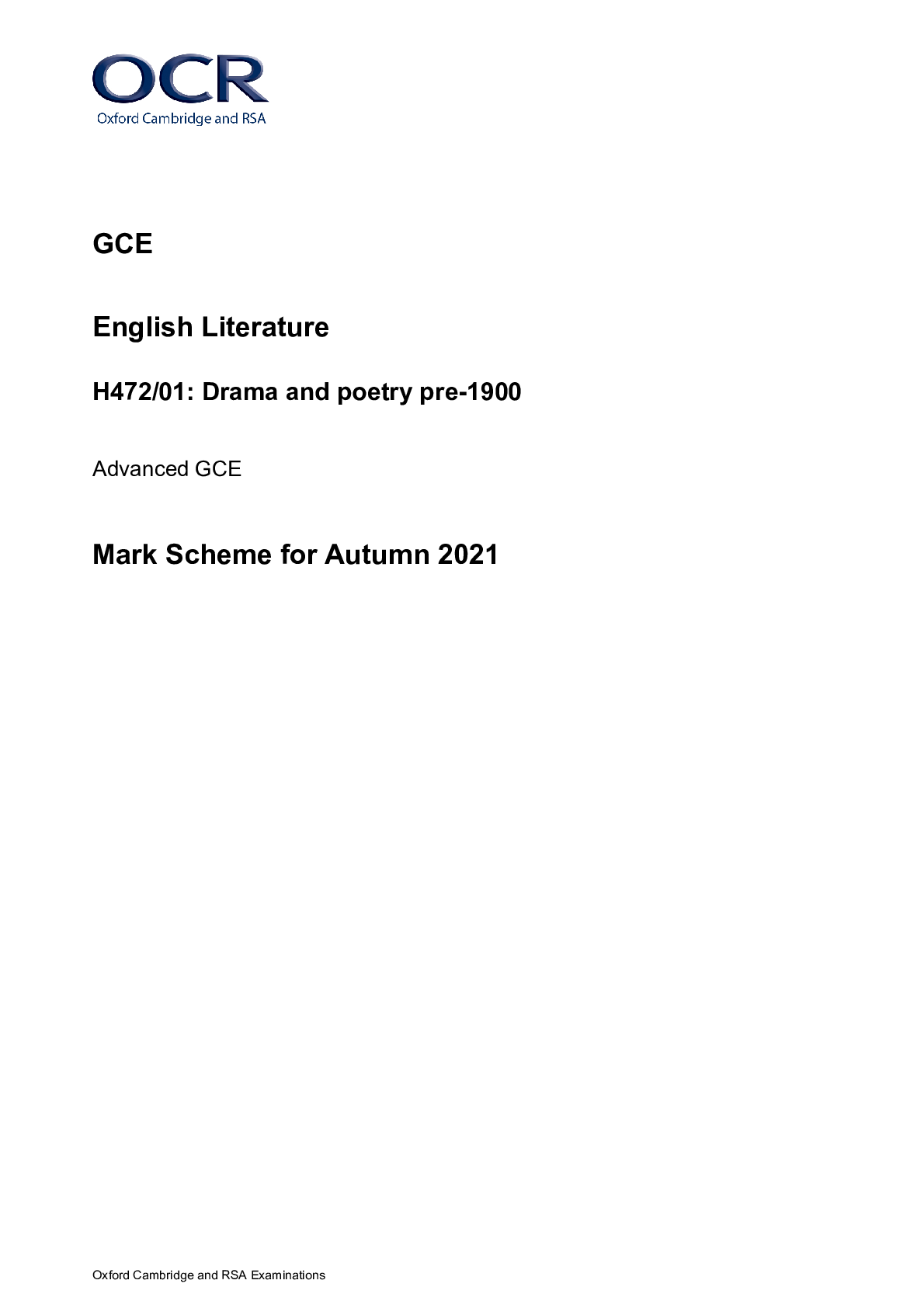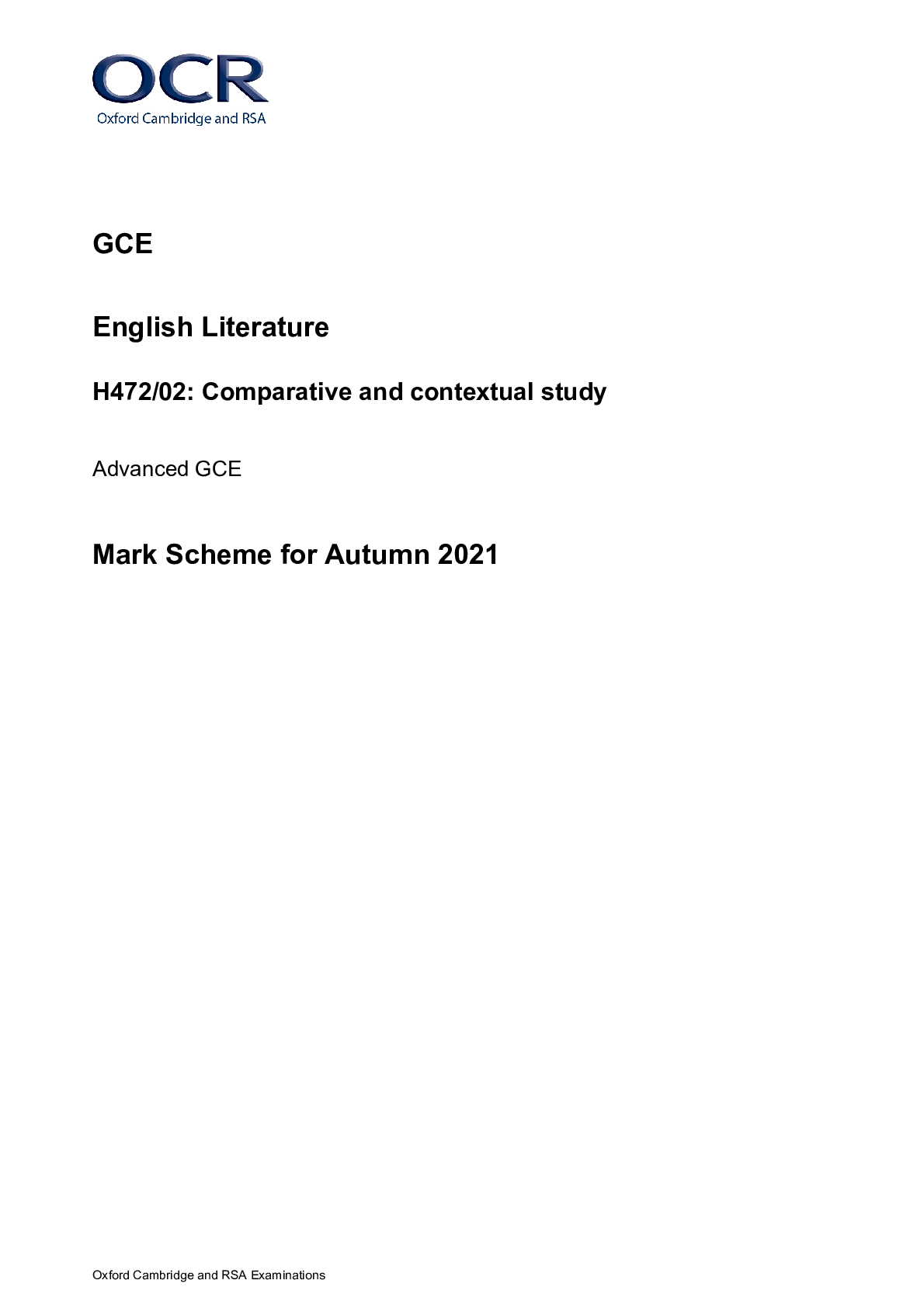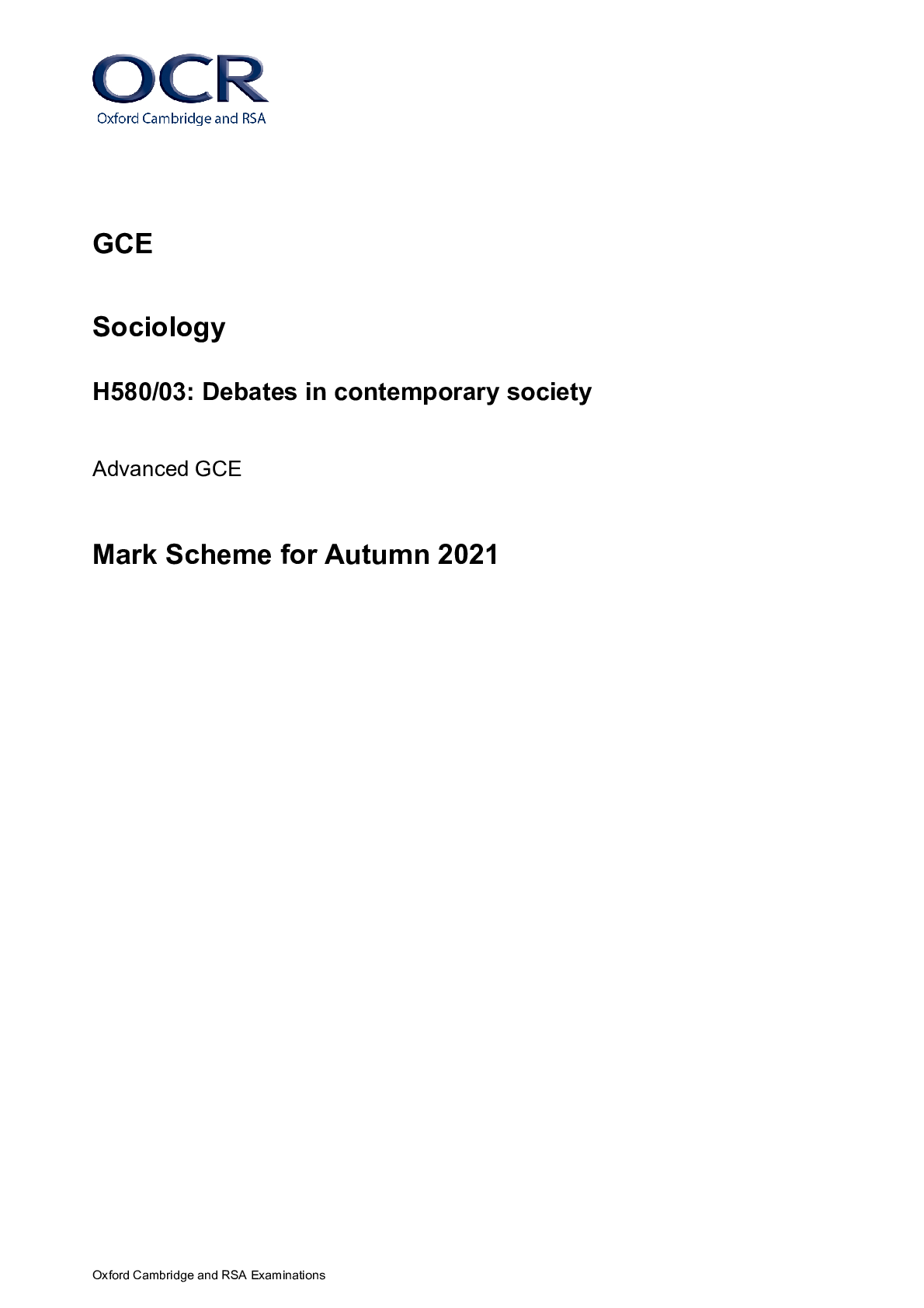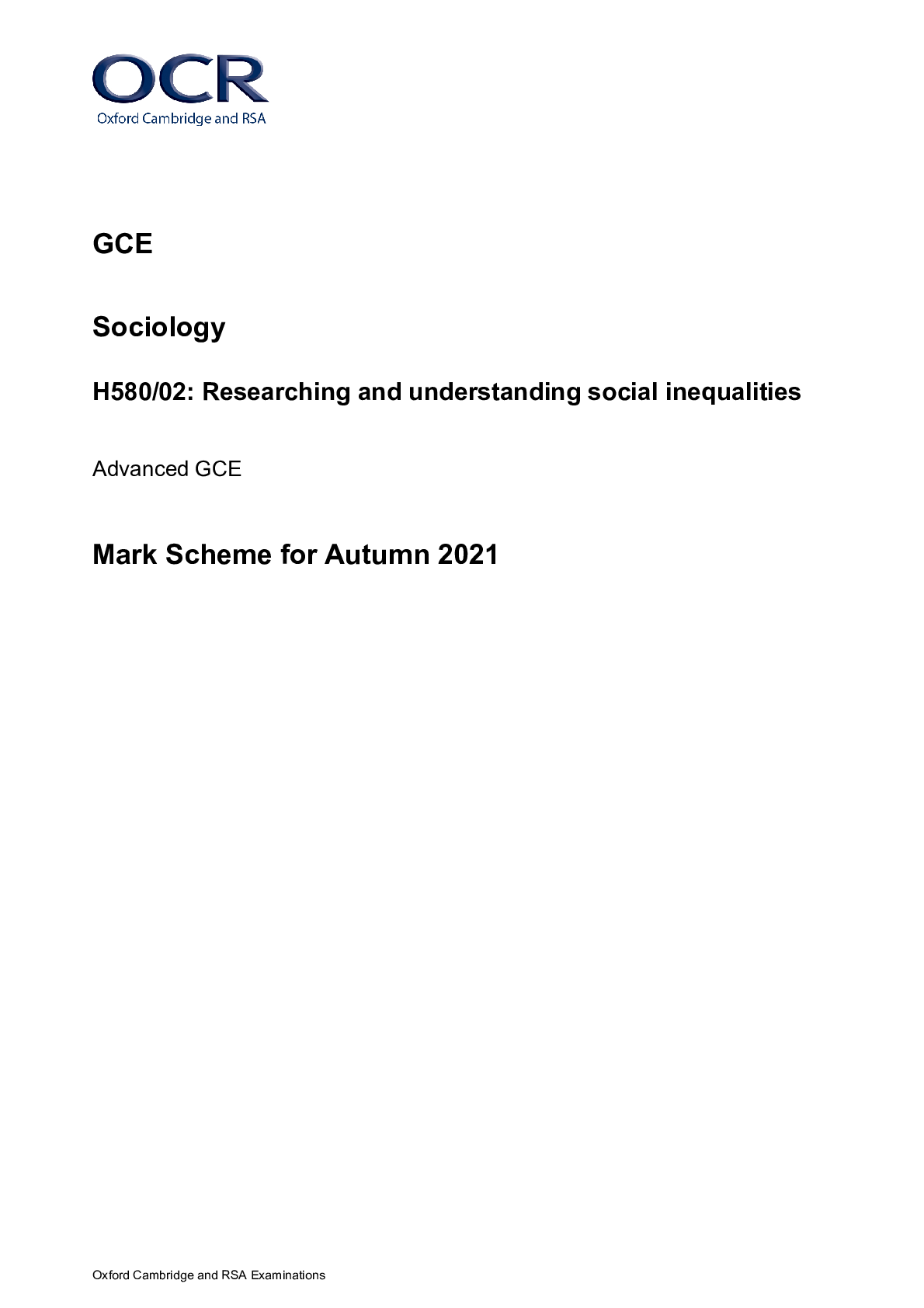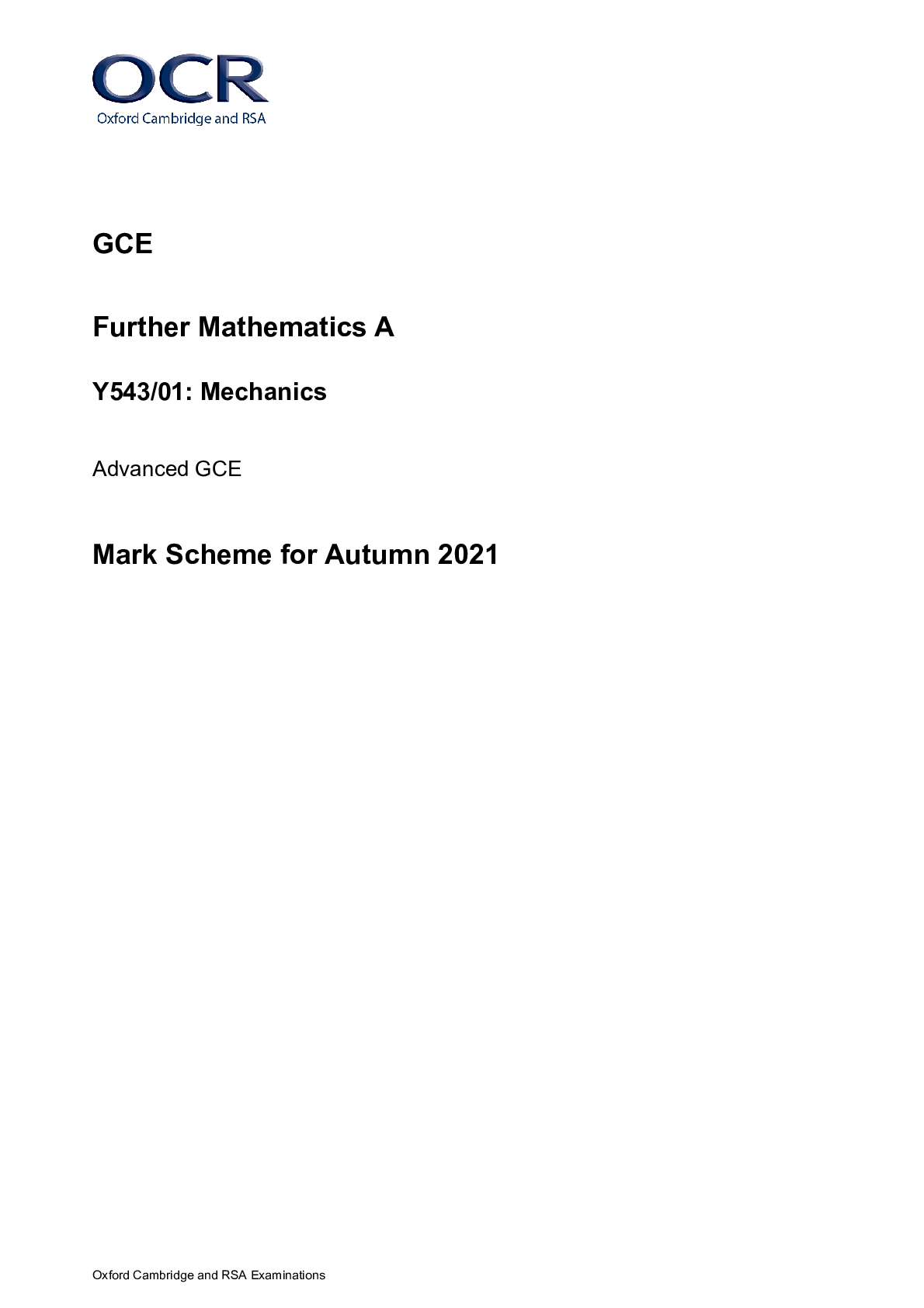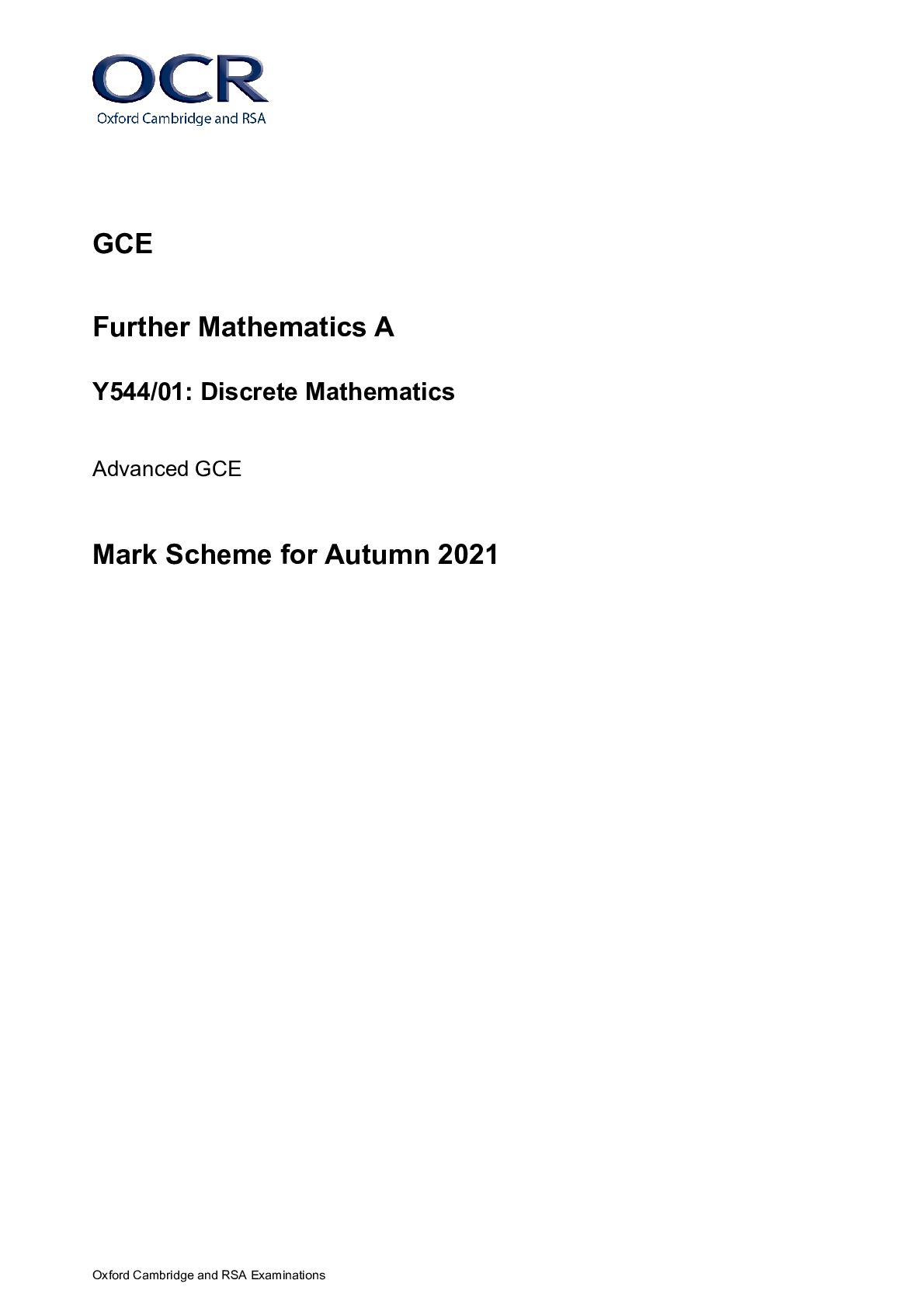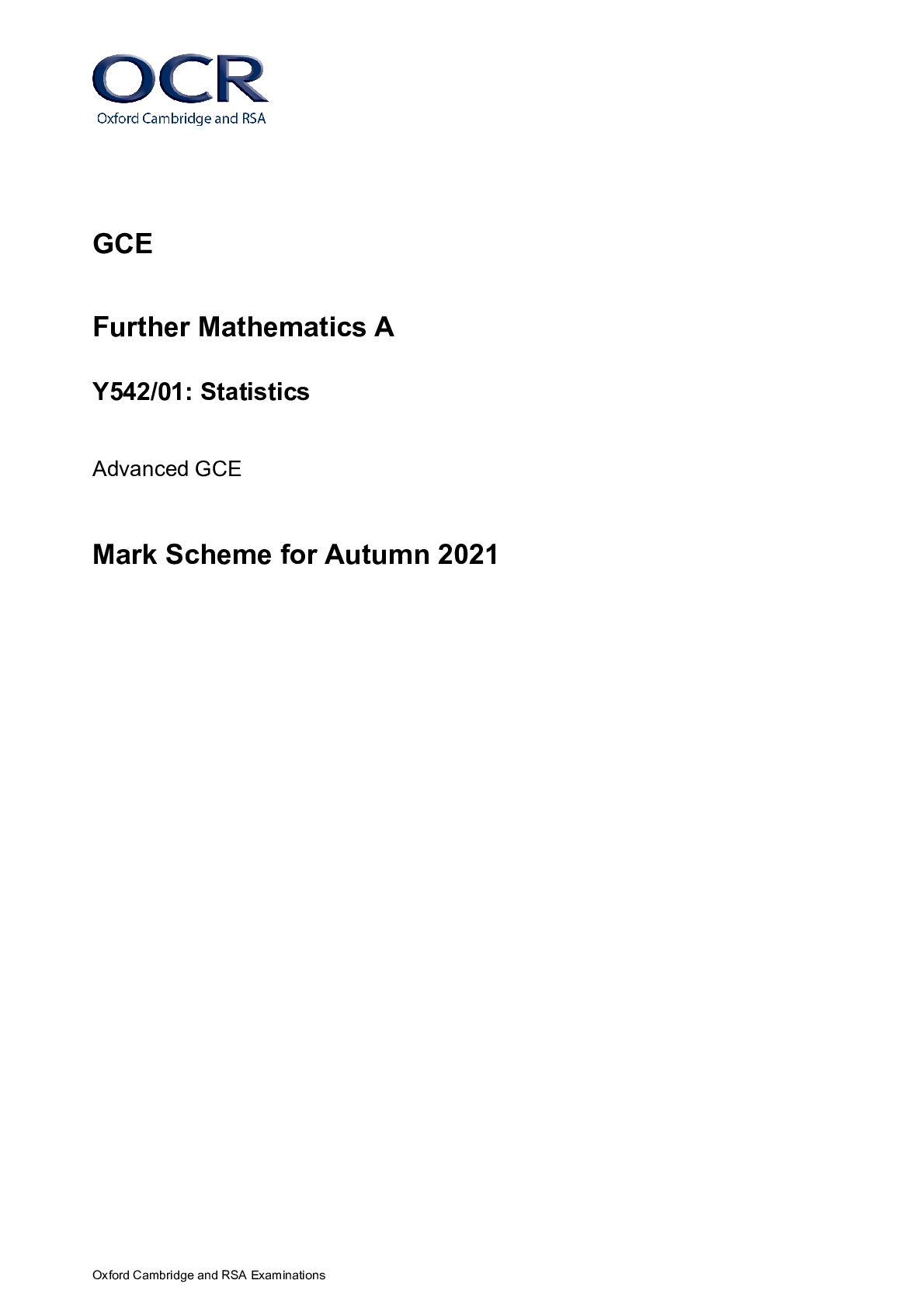History > MARK SCHEME > GCE History A Y104/01: England 1377-1455 Advanced GCE Mark Scheme for November 2020 (All)
GCE History A Y104/01: England 1377-1455 Advanced GCE Mark Scheme for November 2020
Document Content and Description Below
GCE History A Y104/01: England 1377-1455 Advanced GCE Mark Scheme for November 2020 Oxford Cambridge and RSA Examinations GCE History A Y104/01: England 1377-1455 Advanced GCE Mark Scheme for No... vember 2020Oxford Cambridge and RSA Examinations OCR (Oxford Cambridge and RSA) is a leading UK awarding body, providing a wide range of qualifications to meet the needs of candidates of all ages and abilities. OCR qualifications include AS/A Levels, Diplomas, GCSEs, Cambridge Nationals, Cambridge Technicals, Functional Skills, Key Skills, Entry Level qualifications, NVQs and vocational qualifications in areas such as IT, business, languages, teaching/training, administration and secretarial skills. It is also responsible for developing new specifications to meet national requirements and the needs of students and teachers. OCR is a not-for-profit organisation; any surplus made is invested back into the establishment to help towards the development of qualifications and support, which keep pace with the changing needs of today’s society. This mark scheme is published as an aid to teachers and students, to indicate the requirements of the examination. It shows the basis on which marks were awarded by examiners. It does not indicate the details of the discussions which took place at an examiners’ meeting before marking commenced. All examiners are instructed that alternative correct answers and unexpected approaches in candidates’ scripts must be given marks that fairly reflect the relevant knowledge and skills demonstrated. Mark schemes should be read in conjunction with the published question papers and the report on the examination. © OCR 20202 PREPARATION FOR MARKING ON-SCREEN 1. Make sure that you have accessed and completed the relevant and training packages for on-screen marking: scoris assessor Online Training and the OCR Essential Guide to Marking. 2. Make sure that you have read and understood the Instructions for On-Screen Marking and the mark scheme and the question paper for this unit. These are posted on the RM Cambridge Assessment Support Portal http://www.rm.com/support/ca 3. Log-in to scoris and mark the required number of practice responses and the required number of standardisation responses. PREPARATION FOR PAPER BASED MARKING 1. Make sure that you have accessed and completed the relevant training for paper based marking. 2. Make sure that you have read and understood the Instructions for Specialist Marking and the mark scheme and the question paper for this unit. 3. Before the Standardisation meeting you must mark at least 10 scripts from several centres. Use pencil and follow the mark scheme. Bring these marked scripts to the meeting3 MARKING INSTRUCTIONS – FOR MARKING ON-SCREEN AND FOR PAPER BASED MARKING 1. Mark strictly to the mark scheme. 2. Marks awarded must relate directly to the marking criteria. 3. The schedule of dates is very important. It is essential that you meet the scoris 50% and 100% (traditional 40% Batch 1 and 100% Batch 2) deadlines. If you experience problems, you must contact your Team Leader (Supervisor) without delay. 4. If you are in any doubt about applying the mark scheme, consult your Team Leader by telephone or the scoris messaging system, or by email. 5. Crossed Out Responses Where a candidate has crossed out a response and provided a clear alternative then the crossed out response is not marked. Where no alternative response has been provided, examiners may give candidates the benefit of the doubt and mark the crossed out response where legible. Rubric Error Responses – Optional Questions Where candidates have a choice of question across a whole paper or a whole section and have provided more answers than required, then all responses are marked and the highest mark allowable within the rubric is given. Enter a mark for each question answered into RM assessor, which will select the highest mark from those awarded. (The underlying assumption is that the candidate has penalised themselves by attempting more questions than necessary in the time allowed.) Multiple Choice Question Responses When a multiple choice question has only a single, correct response and a candidate provides two responses (even if one of these responses is correct), then no mark should be awarded (as it is not possible to determine which was the first response selected by the candidate). When a question requires candidates to select more than one option/multiple options, then local marking arrangements need to ensure consistency of approach. Contradictory Responses When a candidate provides contradictory responses, then no mark should be awarded, even if one of the answers is correct.4 Short Answer Questions (requiring only a list by way of a response, usually worth only one mark per response) Where candidates are required to provide a set number of short answer responses then only the set number of responses should be marked. The response space should be marked from left to right on each line and then line by line until the required number of responses have been considered. The remaining responses should not then be marked. Examiners will have to apply judgement as to whether a ‘second response’ on a line is a development of the ‘first response’, rather than a separate, discrete response. (The underlying assumption is that the candidate is attempting to hedge their bets and therefore getting undue benefit rather than engaging with the question and giving the most relevant/correct responses.) Short Answer Questions (requiring a more developed response, worth two or more marks) If the candidates are required to provide a description of, say, three items or factors and four items or factors are provided, then mark on a similar basis – that is downwards (as it is unlikely in this situation that a candidate will provide more than one response in each section of the response space.) Longer Answer Questions (requiring a developed response) Where candidates have provided two (or more) responses to a medium or high tariff question which only required a single (developed) response and not crossed out the first response, then only the first response should be marked. Examiners will need to apply prof essional judgement as to whether the second (or a subsequent) response is a ‘new start’ or simply a poorly expressed continuation of the first response. 6. Always check the pages (and additional objects if present) at the end of the response in case any answers have been continued there. If the candidate has continued an answer there then add a tick to confirm that the work has been seen. 7. Award No Response (NR) if: • there is nothing written in the answer space. Award Zero ‘0’ if: • anything is written in the answer space and is not worthy of credit (this includes text and symbols). Team Leaders must confirm the correct use of the NR button with their markers before live marking commences and should check this when reviewing scripts. 8. The scoris comments box is used by your team leader to explain the marking of the practice responses. Please refer to these comments when checking your practice responses. Do not use the comments box for any other reason. If you have any questions or comments for your team leader, use the phone, the scoris messaging system, or e-mail.5 9. For answers marked by levels of response: a. To determine the level – start at the highest level and work down until you reach the level that matches the answer b. To determine the mark within the level, consider the following: Descriptor Award mark On the borderline of this level and the one below At bottom of level Just enough achievement on balance for this level Above bottom and either below middle or at middle of level (depending on number of marks available) Meets the criteria but with some slight inconsistency Above middle and either below top of level or at middle of level (depending on number of marks available) Consistently meets the criteria for this level At top of level 10. These are the annotations, (including abbreviations), including those used in scoris, which are used when marking Annotation Meaning of annotation Blank Page Highlight Off-page comment Assertion Analysis Evaluation Explanation Factor Illustrates/Describes Irrelevant, a significant amount of material that does not answer the question Judgement6 Knowledge and understanding Provenance Simple comment Unclear View 11. Here are the subject specific instructions for this question paper Subject specific marking instructions that apply across the whole question paper must appear here. These must be compatible with the OCR Marking Instructions above. Include here any instructions for marking when a candidate has infringed the rubric.7 12. Here is the mark scheme for this question paper. MARK SCHEME Section A Question Answer/Indicative content Mark Guidance 1 Using these four sources in their historical context, assess how far they support the view that the main cause of divisions in the country in 1386 was money. • In discussing how Source A does not support the view, candidates might refer to the threat from France and hostility to de la Pole, which were both causes of division. • In discussing the provenance of Source A, answers might comment that the source, possibly compiled in Canterbury, is generally reliable for this part of the reign, but was written with the knowledge of how Richard’s reign ended. • In discussing the historical context of Source A, answers might refer to the increasing threat from the other side of the Channel, where the French king had taken over Flanders, and to Richard’s reluctance to send an expedition to help Ghent. In 1386 there was a distinct threat of a French invasion. • In discussing how Source B does not support the view, candidates might refer to the divisions between the king and his uncles being caused by both parties and leading to political instability. • In discussing the provenance of Source B, answers might comment on the fact that Froissart was generally well-informed even on English affairs as he had access to court circles. • In discussing the historical context of Source B, 30 • No set answer is expected. • At Level 5 there will be judgement about the issue in the question. • To be valid judgements they must be supported by accurate and relevant material. • At Level 4 and below, answers may be simply a list of which sources support or challenge the view in the question. • Knowledge must not be credited in isolation, it should only be credited where it is used to analyse and evaluate the sources, in line with the descriptions in the levels mark scheme.8 answers might argue that the attempts of Richard’s advisers to overthrow Gaunt in 1384 illustrates the strength of feeling on their part and contributed to internal divisions. • In discussing how Source C supports the view, candidates might refer to the perception that the king was short of money because of his poor government and that this had a serious impact on his image and on his ability to fight the French and the latter was one of the major problems of the period. • In discussing the provenance of Source C, answers might refer to Statutes of the Realm as accurate representations of what was decided in parliament. • In discussing the historical context of Source C, answers might refer to the considerable demands for taxation from this parliament, (four fifteenths and two tenths) which led to extreme discontent and to the removal of de la Pole from office, which upset Richard. • In discussing how Source D does support the view, answers might refer to the blame for problems being attributed entirely to the king’s poverty and consequent need for heavy taxation. • In discussing the provenance of Source D, answers might comment on the obvious hostility of Favent to the royal advisers and that his highlycoloured rhetorical work was written to defend the actions of the Lords Appellant. • In discussing the historical context of Source D, answers might argue that the clear discontent described here led on to the insistence that Richard take advice from a ‘great and continual council’ which showed the extent to which the problems were caused by money.9 2* Section B Henry IV was never secure on the throne of England? How far do you agree? In arguing that Henry IV was never secure, • Answers might suggest that the spate of rebellions in the early part of the reign could have unseated him. • Answers might argue that Henry was never secure financially as he had heavy expenses in dealing with rebellions and the Scots and spent a good deal on patronage to keep barons loyal. • Answers might consider that Henry did not succeed in keeping the factional struggles of his later years under control. • Answers might consider that the circumstances of his accession meant Henry faced the problem that some saw him as an illegitimate ruler, and he could not overcome this. In arguing that Henry was secure, • Answers might consider that he dealt with the problem of Richard II and so removed a focus of plots. • Answers might consider that Henry dealt successfully with a series of plots and rebellions, such as the Epiphany Plot, the rising of Glyndwr and acted very promptly to deal with the Percy rebellion in 1405. • Answers might consider the defeat of the Scots at Homildon Hill. • Answers might argue that Henry took firm action to deal with the Lollards. 20 • No set answer is expected. • At higher levels, candidates will focus on weighing up the degree of security; but at Level 4, may simply list what Henry did or the challenges he faced. • At Level 5 and above there will be judgement as to the whether Henry was secure or not. • At higher levels candidates might establish criteria upon which to base the judgement as to the extent of his security. • To be valid judgements, claims must be supported by relevant and accurate material. If not, they are assertions. • Knowledge must not be credited in isolation, it should only be credited where it is used as the basis for analysis and evaluation, in line with the descriptions in the levels mark scheme.10 3* • Answers may also note that, despite earlier problems, the succession of Henry V occurred in an orderly fashion How far were the ambitions of the duke of York the reason for the outbreak of civil war in 1455? In arguing that the ambitions of the Duke of York were the main cause, • Answers might consider that York had a viable claim to the throne. • Answers might consider that York had support within the country as shown by Cade’s rebellion. • Answers might refer to the way York felt resentful about how he had been treated by the king and this fuelled his ambition. • Answers might suggest that York had been able to show he could govern the country when Henry VI was ill and so was ambitious to do so again. • Answers might argue that the backing of Warwick gave York the means to express his ambition. In arguing that there are other explanations, • Answers might suggest that the failure of the king to maintain law and order was a cause of noble factional fighting. • Answers might consider that the role of the duke of Somerset in government antagonised many nobles. • Answers might suggest that Henry VI was not blameless, although popular opinion was reluctant to criticise the king. His use of patronage led to discontent. 20 • No set answer is expected. • At higher levels, candidates will be focus on weighing up the importance of the reasons but at level 4, may simply list the causes of the war. • At Level 5 and above there will be judgement as to the extent of York’s culpability. • At higher Levels candidates might establish criteria against which to judge the relative importance of the different reasons. • To be valid judgements, claims must be supported by relevant and accurate material. If not, they are assertions. • Knowledge must not be credited in isolation, it should only be credited where it is used as the basis for analysis and evaluation, in line with descriptions in the levels mark scheme.11 • Answers might argue that Margaret of Anjou’s fierce defence of the rights of her son and her fear of York was a factor.12 APPENDIX 1 – this contains a generic mark scheme grid AO2: Analyse and evaluate appropriate source materials, primary and/or contemporary to the period, within its historical context. Generic mark scheme for Section A, Question 1: How far do the four sources support the view? [30] Level 6 26–30 marks The answer has a very good focus on the question throughout. The sources are fully evaluated, using both provenance and detailed and accurate knowledge of their historical context in a balanced way, in order to engage with the sources and reach a convincing, fully supported analysis of them in relation to the issue in the question. Level 5 21–25 marks The answer has a good focus on the question. The sources are evaluated, using both provenance and relevant knowledge of their historical context, in order to engage with the sources and reach a supported analysis of them in relation to the issue in the question. There may be some imbalance in the analysis between use of provenance and use of knowledge. Level 4 16–20 marks The answer is mostly focused on the question. The sources are evaluated, using both provenance and generally relevant knowledge of their historical context, in order to engage with the sources and produce an analysis of them in relation to the question. The use of provenance may not be developed. Level 3 11–15 marks The answer is partially focused on the question. There is partial evaluation of the sources, with use of some knowledge of their historical context, in order to engage with the sources and produce a partial analysis of them in relation to the question. Level 2 6–10 marks The answer has only limited focus on the question. Evaluation of the sources is very general. There is limited use of generalised knowledge of historical context to engage with the sources and produce a basic analysis of them in relation to the question. Level 1 1–5 marks This answer is on the wider topic area, but not on the detail of the question. The sources are evaluated in a very basic way, primarily being used as a source of information with understanding of them being only partial. A very generalised knowledge of historical context is used in a very limited way to engage with the sources and to attempt a very simple analysis of them in relation to the question. 0 marks No evidence of understanding or reference to the sources. AO1: Demonstrate, organise and communicate knowledge and understanding to analyse and evaluate the key features related to the periods studied, making substantiated judgements and exploring concepts, as relevant, of cause, consequence, change, continuity, similarity, difference and significance. Generic mark scheme for Section B, Questions 2 and 3: Essay[20]13 Level 6 17–20 marks There is a consistent focus on the question throughout the answer. Accurate and detailed knowledge and understanding is demonstrated throughout the answer and is consistently evaluated and analysed in order to reach substantiated, developed and sustained judgements. There is a well-developed and sustained line of reasoning which is coherent and logically structured. The information presented is entirely relevant and substantiated. Level 5 13–16 marks There is a mostly consistent focus on the question. Generally accurate and detailed knowledge and understanding is demonstrated through most of the answer and is evaluated and analysed in order to reach substantiated judgements, but these are not consistently well-developed. There is a well-developed line of reasoning which is clear and logically structured. The information presented is relevant and in the most part substantiated. Level 4 10–12 marks The question is generally addressed. Generally accurate and sometimes detailed knowledge and understanding is demonstrated through most of the answer with evaluation and some analysis, and this is used appropriately to support the judgements that are made. There is a line of reasoning presented with some structure. The information presented is in the most-part relevant and supported by some evidence. Level 3 7–9 marks The question is partially addressed. There is demonstration of some relevant knowledge and understanding, which is evaluated and analysed in parts of the answer, but in places knowledge is imparted rather than being used. The analysis is appropriately linked to the judgements made, though the way in which it supports the judgements may not always be made explicit. The information has some relevance and is presented with limited structure. The information is supported by limited evidence. Level 2 4–6 marks The focus is more on the topic than the specific demands of the question. Knowledge and understanding is limited and not well used, with only limited evaluation and analysis, which is only sometimes linked appropriately to the judgements made. The information has some relevance, but is communicated in an unstructured way. The information is supported by limited evidence and the relationship to the evidence may not be clear. Level 1 1–3 marks The answer relates to the topic but not the specific question. The answer contains only very limited relevant knowledge which is evaluated and analysed in a very limited way. Judgements are unsupported and are not linked to analysis. Relevant knowledge is limited, generalised and poorly used; attempts at argument are no more than assertion. Information presented is basic and may be ambiguous or unstructured. The information is supported by limited evidence. 0 marks No evidence of understanding and no demonstration of any relevant knowledge.14 APPENDIX 2 – this section contains additional subject specific information Use this space if you have extensive subject specific information that is inappropriate to include elsewhere.OCR (Oxford Cambridge and RSA Examinations) The Triangle Building Shaftesbury Road Cambridge CB2 8EA [Show More]
Last updated: 1 year ago
Preview 1 out of 16 pages
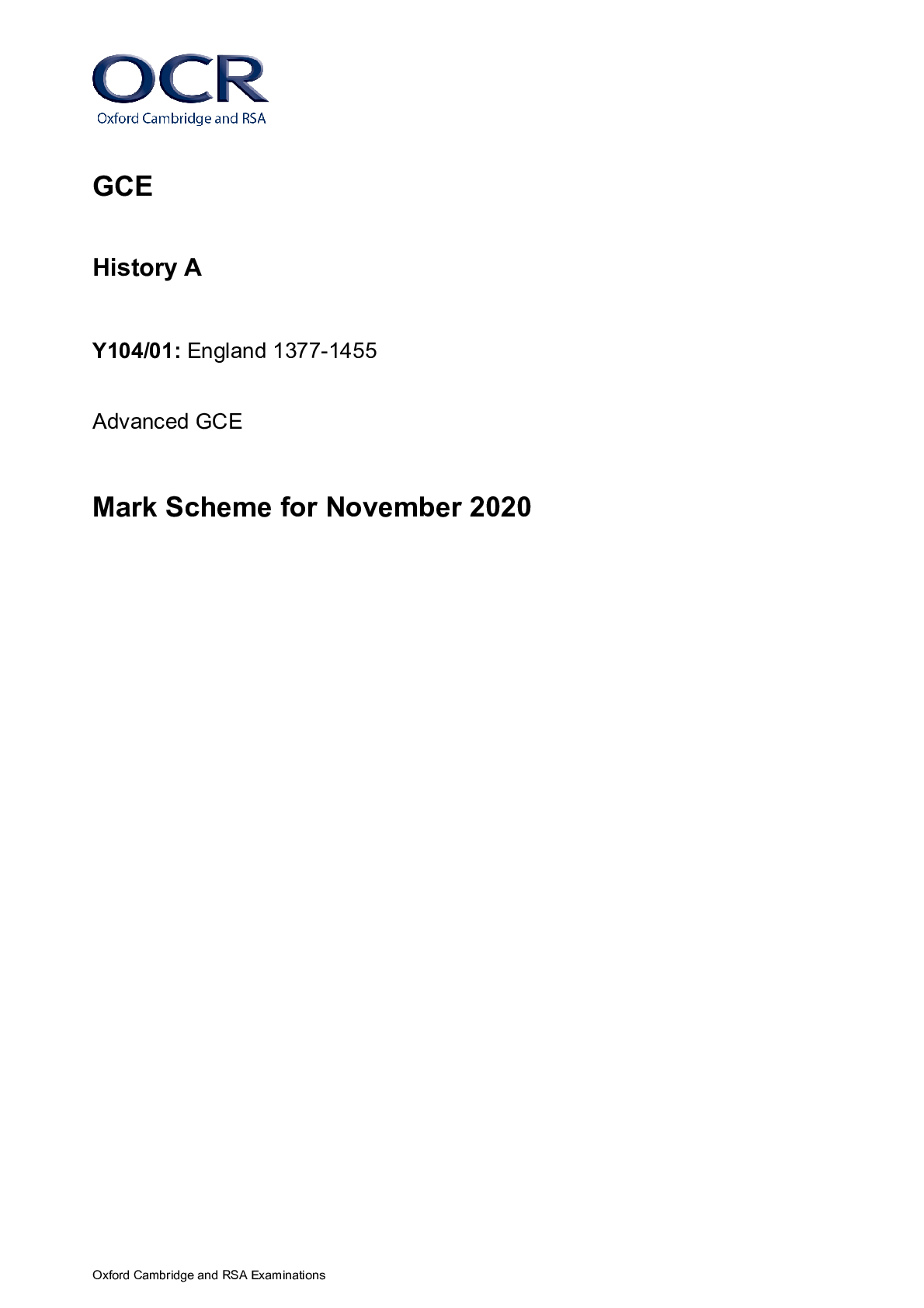
Reviews( 0 )
Document information
Connected school, study & course
About the document
Uploaded On
Jul 17, 2022
Number of pages
16
Written in
Additional information
This document has been written for:
Uploaded
Jul 17, 2022
Downloads
0
Views
38

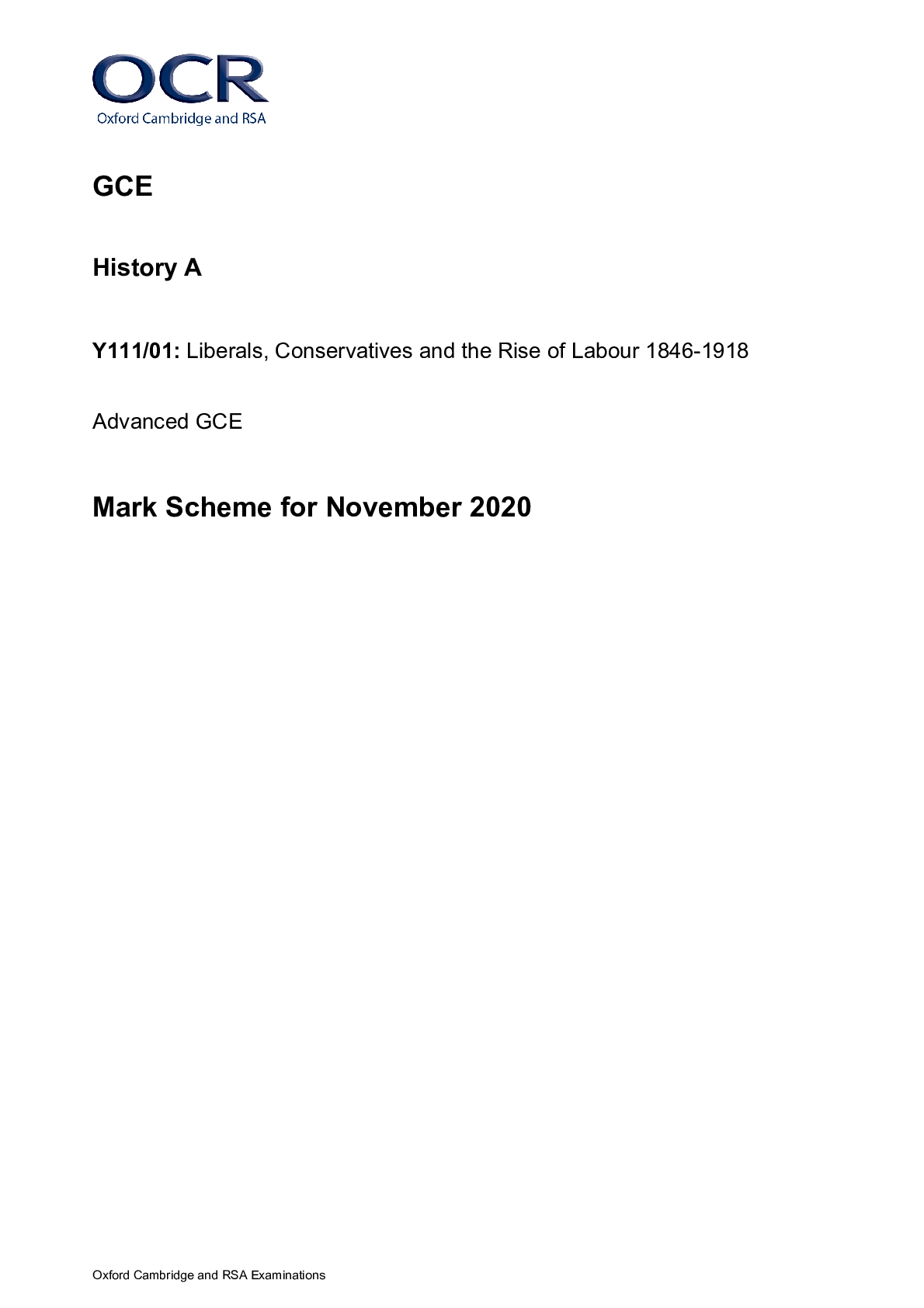
.png)
